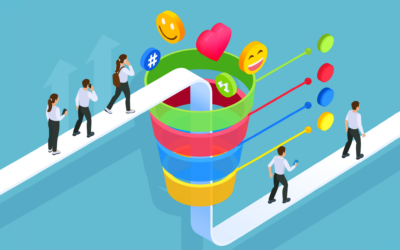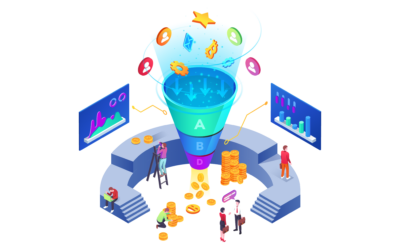How to Optimize Your Sales Funnel
Are you not getting the expected results from your marketing campaign? Are you trying to find better ways to increase revenue, increase conversions, and produce leads? Then your sales funnel has to be optimized. Probably.
If you’ve worked in marketing for any duration of time, you may be familiar with the phrase “sales funnel.” If not, don’t worry—we’ll explain what it means and how to optimize your sales funnel. As simple as it may seem, selling goods or services online is not as simple as it once appeared. Before your audience becomes a customer, you must guide them through many stages.
The term “sales funnel” refers to the process by which a potential client must travel through several stages. Essentially, the route is divided into many phases, including Prospects, Leads, Connection, Follow-up, Conversion, and Sales.
In other words, a sales funnel essentially maps out a path from prospect analysis and lead generation to real customer acquisition. Depending on your audience and the nature of your business, this journey might be lengthy or quick. To effectively move your consumer from the previous phase to the next, you must put in a lot of work.
Depending on the target market, product, and aim of the firm, these sales funnels might fluctuate but the stages will always remain the same.
What is a Sales Funnel?
The sales funnel may be broadly classified into three sections: top, middle, and bottom. While making judgments about what to buy, the target audience that is not familiar with the good or service follows these processes. To move prospects to the next stage, each phase requires a unique strategy made up of landing sites, blogs, offers, advertisements, and demonstrations.
While the bottom-of-the-funnel approach exclusively concentrates on turning prospects into customers, the top-of-the-funnel strategy seeks to educate the audience about the product and gather emails from interested prospects.
How to Optimize Sales Funnel:
Increasing sales and revenue requires an optimized sales funnel. Until the consumer completes a purchase, you may qualify your prospects and move them down the sales funnel.
1. Determine who your target audience is:
First of all, if you don’t know who your target market is, how are you going to optimize your sales funnel? Gaining insight into your clientele will improve the way you sell your goods or services. Even if you have the greatest sales funnel in the business, it is useless if it is not reaching the right customers.
Making a customer persona is the most effective approach to determining your target market. In this manner, you will be able to get a general idea of your customers’ characteristics, methods of thought, and reasons for purchasing. You can more effectively attract customers at the top of your funnel by developing a buyer persona.
Use data from your Google Analytics, social media, and customer database. Demographics like Age, Occupation, Location, Interests, Technology, and Preferred Social Media platforms should be your main focus.
Create an outline of your ideal customer using the information you obtained. Create many personalities for your target demographic and keep an eye out for recurring tendencies. It’s possible to set a million individuals as your target market, but how many of them will purchase your goods? You may more effectively target consumers and convert them to paying customers by developing buyer personas.
2. Analyze the Performance of Your Landing Pages:
Are the individuals who see your landing pages targeted correctly? Landing pages should serve your client’s requirements, even if they can also be used to advertise your goods or services or as a general source of information about your business and what you have to offer. For instance, your landing page should indicate that your client is searching for “video conferencing” software, or else they would go elsewhere.
Remember that your landing page is the first place that potential clients will learn about the goods and services you have to offer. You will need to put in a lot of work if your landing page does not convert prospects in your sales funnel, since the average landing page conversion rate across all sectors is 9.7%, according to Hubspot. Conversion rates can increase by 80% when landing pages address buyer anxieties.
To improve the chance that your landing page will appear in search results, make sure it is SEO-optimized for both standard and Google Maps results. As a result, landing pages are essential to your marketing plan.
3. Enhance Your Call to Action:
One of the most crucial components of your sales funnel is the call to action. It leads your clients on the path that you desire. Your call to action needs to be very clear, whether you want them to buy something, join an email list, or subscribe to your newsletter. CTAs facilitate the prospect’s descent down the sales funnel by removing obstacles.
Although calls to action (CTAs) are essential for boosting conversion rates, you don’t want to overburden customers with them. For them, it can become too much, which might cause them to get confused and frustrated. A call to action shouldn’t appear on every page. Other pages require one, others demand many, and some might not require any at all.
To convert a prospect, the call to action must be placed correctly. There are several advantages to having your call to action beyond the main content for your website. A call to action that is positioned above the fold will be more visible than one that is below. People who visit your website won’t want to scroll down to see what the next stage of the customer journey is.
4. Set Measurable Objectives and Monitor Key Metrics:
You can’t optimize a sales funnel by setting it and forgetting it. As your company expands and your customers’ demands change, you must keep an eye on every part of the funnel and optimize it to find areas that might work better.
Using Google Analytics is a simple approach to monitor important sales funnel data. It helps you in tracking progress while applying changes, visualizing your sales funnel, and identifying drop-off areas.
5. Build Trust Indications Into Your Website:
Prospects that don’t trust your website may not convert for several of reasons. Either your offer seems too good to be true, or they don’t believe your salespeople. By incorporating social proof and trust signals into your website, you can tackle this issue. Your website’s trustworthiness can be increased with the use of trust signals.
When making riskier decisions, online shoppers depend more on their gut feeling than on reason and protocol. Therefore, a consumer won’t interact with you if they don’t trust your brand. Customers are more confident doing business with you when you provide trust signals. As a result, you must ensure that your trust signals are clearly visible on your website.
However, trust signals are only useful when carefully positioned throughout your website, much like your call to action. It will not only help you become more credible, but it will also provide the buyer more assurance that they chose wisely to purchase from you.
6. Real-Time Engagement:
Simply being active on social media is useless if you don’t interact with potential customers. According to studies, spending on customer involvement can lead to a 70% rise in average revenue. If you aren’t investing in customer engagement now, you can be missing out on potential business since it is predicted to double in value by 2025.
What is the best way to boost client engagement? Simply be there to assist your clients at all times. If you are unable to accomplish that, then make it simple for your clients to contact you with any inquiries. One way you can engage with them or other consumers is by setting up a virtual community on Facebook Messenger.
Customers want brands to listen to and understand them. They get the impression that you are interested in what matters to them when you connect with them in real-time. They expect prompt and efficient solutions from you. They will probably locate it elsewhere if they are unable get it from you.
7. Use Social Media to Your Advantage:
In today’s digital world, failing to be present on social media is a significant error for any company. Having a social media presence on sites like Facebook, Twitter, and LinkedIn may improve your sales funnel. 72% of clients use social media daily. Social media is great for connecting with prospects at every level of the funnel, but it can also help you target those at the top.
Social media reaches every customer journey step. It assists you in reaching objectives including increasing brand recognition, attracting rivals’ interest, gaining direct website followers, and making sales straight from your app store. Social media can be used to start a remarketing campaign and get clients back. Through interesting content, social media can be useful in reaching out to new consumers.
Social media platforms can help you in gathering data as well. You will be able to determine how to impact your clients at every level of the funnel by using the data you have gathered. All things considered, adding social media to your sales funnel may greatly simplify the client experience. In the end, it will support the development of a trustworthy relationship with your client.
8. To nurture leads, use email marketing:
Email marketing is a necessary tool when trying to attract clients and nurture prospects on your sales funnel. It’s not enough to just spark their curiosity; you also need to arouse their interest in your offerings. Email marketing is the most effective method to accomplish this. Even with the increasing number of chatting programs like Messenger, email is still one of the most effective ways to close deals.
Email relationships are prioritized by 86% of professionals. Comparing email marketing to traditional advertising is more economical. You can reach the correct audience, engage with them, and, if feasible, increase sales for a very low price. When implemented correctly, email marketing may benefit your company by establishing connections with clients, increasing trust and brand recognition, transforming potential clients into loyal customers, and offering potential clients value and knowledge.
To increase your clientele and hit your sales targets, make sure your email marketing plan is well-defined. If you merely send out emails without any preparation, it will be a waste of your time and money. You will also have difficulties in business and expansion.
Wrapping it up:
To monitor the effectiveness of your whole marketing strategy and quickly address any flaws, creating a sales funnel is necessary. You can use your sales funnel to identify problems in your marketing efforts and then use that information to further optimize your funnel and get everything back on track.
It is an undeniable reality that while optimizing your sales funnel, you can miss a few crucial details, no matter how hard you try. As you gain expertise, you’ll realize that throughout your marketing campaign, many other factors are just as important as conversion rates.
It will be necessary for you to comprehend your audience’s preferences, expectations, and so on. You will have succeeded in reaching your objective if your sales funnel generates high returns for you. Use your sales funnel as a tool to help you in developing your marketing strategy.





